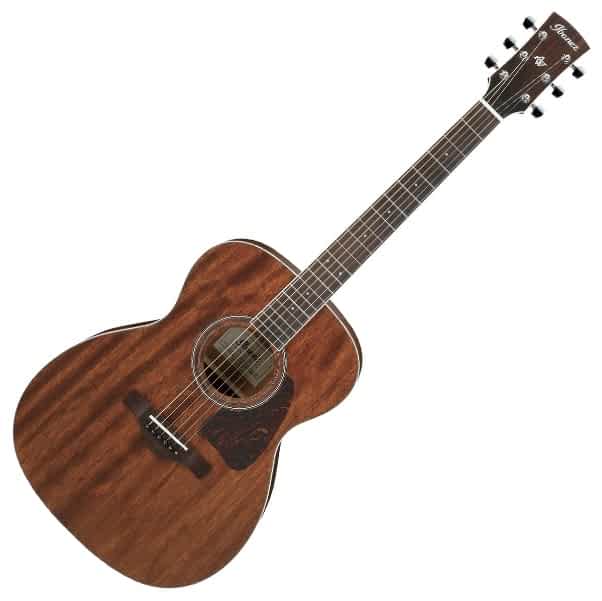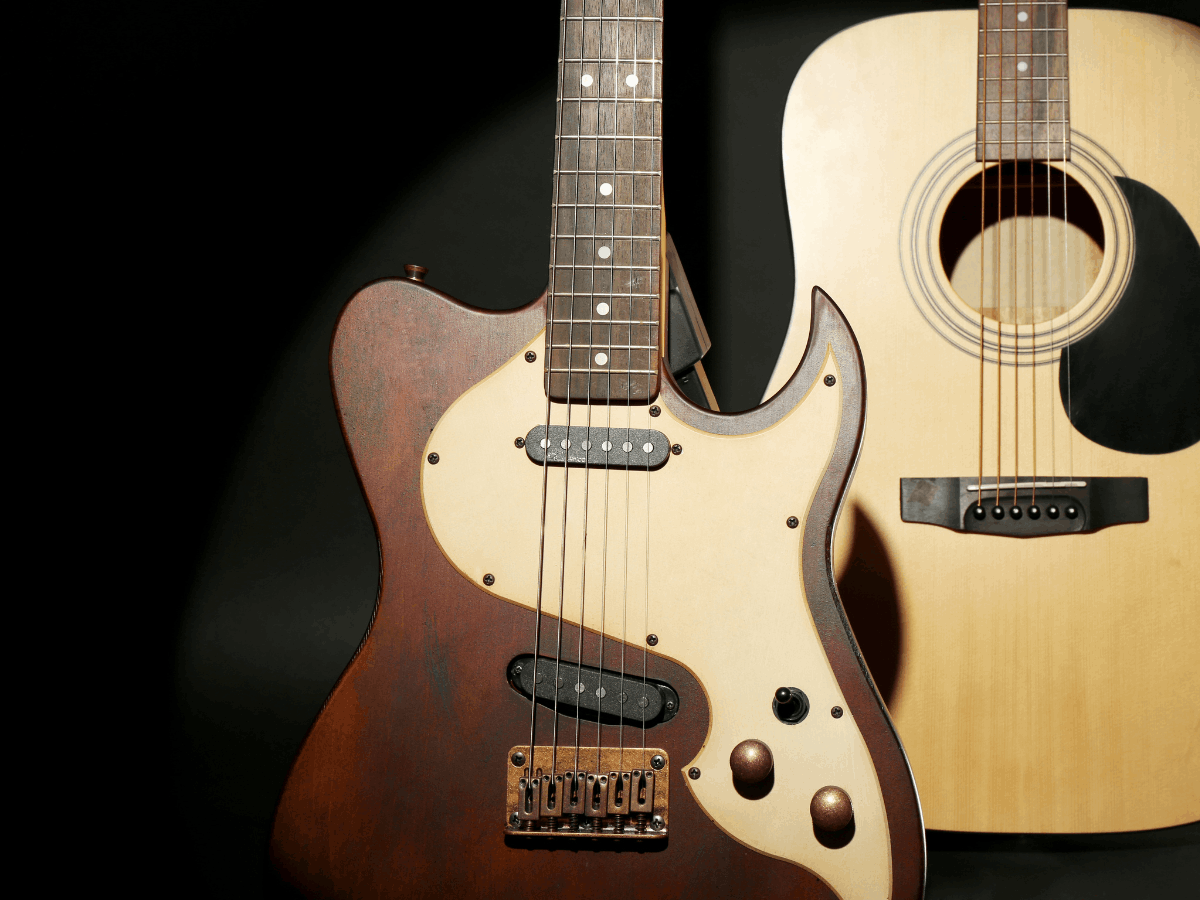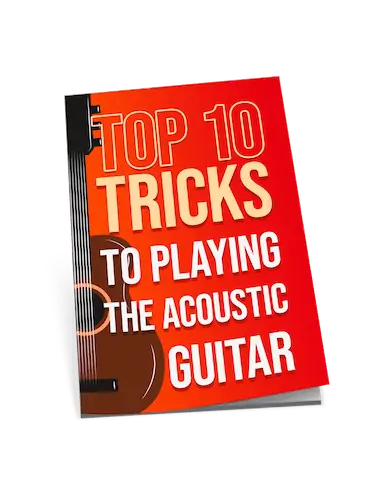Best
Beginner Acoustic Guitar
-
Overall: Low action and comfortable playing experience
-
Best Feature: Excellent tone and projection and attractive body
-
TedScore™: 9/10
Best
Budget Beginner Acoustic Guitar
-
Overall: Fantastic tonal balance with rich bass response
-
Best Feature: Excellent stock tuners keep instruments in tune
-
TedScore™: 9/10
Best
Beginner Electric Guitar
-
Overall: Impressive Stratocaster tones and highly enjoyable to play
-
Best Feature: Variety of switching options and responsive vibrato system
-
TedScore™: 9/10
Learning guitar can feel a bit like trying to conquer a mountain. It depends on how much time and effort you pour in. Some might strum a tune in a few months, while others noodle around for years before feeling comfy with chords. On average, with a good routine and practice, you could start playing simple songs in six months. But here’s a secret not many share: playing along with your favourite tracks speeds up learning like nothing else. Picture yourself jamming along with legends, truly feeling the music. You don’t have to play for hours every day; even 15 minutes can work wonders. So, whether you’re aiming to be a campfire hero or a stage superstar, keep that guitar close and play on. Imagine the joy of eventually playing that song you’ve always loved – that’s the magic waiting for you.
Learning how to play guitar can be one of the most thrilling experiences of your life, but the truth is, it depends on a variety of factors as to how long it’ll take.
However, don’t let that discourage you!
With the right mindset, a lot of practice, and a little patience, you can become a guitar hero in no time.
Understanding the Learning Process of Playing the Guitar
Learning to play the guitar involves acquiring both technical skills and musical knowledge. It starts with learning the basics such as proper hand positions, finger placement, and strumming techniques.
As you progress, you’ll learn chords, scales, and basic music theory. Building muscle memory and developing a sense of rhythm is also essential.
Factors Influencing the Time Required to Learn Guitar
Practice and consistency
Musical background
Learning style
Goals and commitment
Beginner Stage
Factors Influencing the Time Required to Learn Guitar

Learning how to play the guitar is an exciting journey that requires patience, dedication, and consistent effort to practice.
At the beginner stage, it’s important to focus on mastering the basics of guitar playing. To get started playing guitar, familiarize yourself with the different parts of the guitar, understanding how to hold and tune it properly, and learning how to read guitar tabs or sheet music.
Essential Chords And Strumming Techniques

One of the key aspects of learning guitar is becoming comfortable with essential chords and strumming techniques.
Chords are the foundation of many songs, and learning common open chords such as C, G, D, and A is a great starting point.
Alongside chords, practising various strumming patterns to build rhythm and develop coordination between your left and right hand is essential.
Throughout the beginner stage, consistency is critical. Regular practice sessions, even short, will help train your muscles and develop muscle memory.
Learning guitar is a gradual process that varies depending on individual commitment and practice time. Becoming comfortable with the basics could take a few weeks or a couple of months.
To progress from the beginner stage to more advanced levels, it’s important to continually challenge yourself by learning new techniques, scales, and songs. This will help you build a strong foundation and expand your repertoire.
Intermediate Stage
Progressing to more complex chords and fingerpicking

You can start learning more complex chords and chord progressions in the intermediate stage. This will allow you to play various songs and create more interesting musical compositions.
Fingerpicking is another technique that you can begin to explore. It involves using individual fingers to pluck the guitar strings, creating a rich and melodic sound. With practice, you can develop speed and dexterity in your fingerpicking.
Improving rhythm and timing

Rhythm and timing are essential skills for any guitarist. In the intermediate stage, you can improve your sense of rhythm and timing by practising with a metronome or playing with backing tracks.
You can also experiment with different strumming patterns and rhythmic variations to add depth and creativity to your guitar playing.
As an intermediate guitarist, continuing to practise regularly and challenging yourself with new techniques is important.
This stage is about expanding your repertoire and pushing the boundaries of your abilities. You can continue to progress on your guitar journey with dedication and perseverance.
Advanced Stage
Mastering advanced techniques like scales and arpeggios

Rhythm and timing are essential skills for any guitarist. In the intermediate stage, you can improve your sense of rhythm and timing by practising with a metronome or playing with backing tracks.
You can also experiment with different strumming patterns and rhythmic variations to add depth and creativity to your playing.
Exploring different music genres and styles

Once you understand the fundamentals, you can explore different music genres and styles that interest you. This could include jazz, blues, rock, classical, metal, or country music.
By immersing yourself in different genres, you will better understand various playing techniques, chord progressions, and musical concepts specific to each genre.
When learning guitar for more advanced techniques, you must continue practising regularly and challenging yourself with new material.
This will help to develop your skills further and keep pushing the boundaries of your playing abilities.
Practice and Dedication
Learning to play the guitar is a journey that requires time, practice, and dedication. While the exact time it takes to become proficient varies from person to person, key factors can influence your progress.
Consistency Matters: Regular practice is the key to improving your guitar skills. Practising for shorter durations every day rather than longer sessions sporadically is better. This helps build muscle memory and develops your playing technique.
Dedication Pays Off: Learning the guitar requires patience and dedication. Stay committed to your goal and don’t get discouraged if progress sometimes seems slow. With persistence and regular practice, you will see improvement over time.
Tips for effective practice sessions

Set Realistic Goals
Break down your learning into manageable goals. Start with simple chords and gradually progress to more complex techniques.
Vary Your Practice
Mix up your practice routine to keep it engaging. Work on chord progressions, scales, fingerpicking patterns, and learn songs in different genres to expand your repertoire.
Use Online Resources
Use online platforms, tutorials, and apps offering guitar lessons. They provide structured learning materials and exercises suitable for beginners and advanced players.
Record Your Playing
Use a recording device or app to record yourself playing. This allows you to listen back and identify areas for improvement.
Milestones and Timeframe
Tips for effective practice sessions

Learning to play the guitar is an exciting and rewarding experience. Here are some typical milestones that most guitar players go through on their journey to becoming proficient:
- Basic Chords and Strumming: This is usually the starting point for a complete beginner. Learning open chords like C, G, D, and the basic strumming patterns is essential for playing simple songs.
- Barre Chords: Barre chords involve using one finger to press down multiple strings across the fretboard. Mastering barre chords opens up many possibilities and allows players to play more complex songs.
- Fingerpicking: This involves using individual fingers to pluck the strings, creating intricate melodies and rhythms. Developing fingerpicking skills adds depth and versatility to your playing.
- Scales and Improvisation: Learning scales like the pentatonic scale, help players understand music theory and improvisation. This enables them to create their solos and melodies.
Estimated timeframes for reaching each milestone

The time it takes to reach these milestones varies depending on several factors, including practice time, natural ability, and dedication.
However, here are some general estimates for each milestone:
- Basic Chords and Strumming: Most beginners can learn basic chords and strumming patterns within a few weeks of consistent practice.
- Barre Chords: Mastering barre chords can take several months of practice as it requires building finger strength and dexterity.
- Fingerpicking: Developing fingerpicking skills may take several months to a year, depending on the complexity of the patterns and the individual’s learning pace.
- Scales and Improvisation: Learning scales and becoming proficient in improvisation can take several years of dedicated practice and study.
Remember, these timeframes are just estimates, and individual progress will vary. Consistency, regular practice, and patience are key to mastering the guitar.
Overcoming Challenges
Dealing with common challenges and roadblocks
Finger Strength and Dexterity
To overcome this, practice regularly and start with simple exercises focusing on finger strength and coordination.
Learning Chords
Take it one step at a time, starting with basic chords and gradually moving to more complex ones. Practice chord changes slowly and gradually increase your speed.
Rhythm and Timing
Use a metronome or practice with recorded music to improve your timing skills.
Dealing with common challenges and roadblocks
Set Goals
Find Inspiration
Take Breaks

Proven Tips and Techniques to Learn Guitar Faster

- Practice consistently: Set a regular practice schedule and stick to it. Even if it’s just 15-20 minutes a day, consistent practice is key to making progress.
- Focus on technique: Proper technique is essential for playing guitar effectively. Take the time to learn the correct hand positioning, finger placement, and posture.
- Learn music theory: Understanding music theory can help you make sense of the notes and chords you’re playing. This knowledge can also help you write songs.
- Use a metronome: A metronome can help you develop your sense of rhythm and timing. Start with a slow tempo and gradually increase the speed as you improve.
- Learn from others: Seek out a guitar teacher, online tutorials, and other resources to learn new techniques and get feedback on your playing. Collaborating with other musicians can also help you improve your skills.
Our 5 Highly Recommended Acoustic Guitars for Beginners
Fender CD-60 Dreadnought V3, 3-Color Sunburst
The Fender CD-60 is a timeless acoustic guitar that has been a beginner’s go-to choice for many years.
It boasts a solid spruce top and mahogany back and sides, which provides fantastic volume, resonance, and tonal clarity.
The neck is designed for optimal playability, with a slim, comfortable feel and a smooth Walnut Fretboard. The tuners are also top-notch, offering excellent stability and intonation right out of the box.
The V3 model has a new look with a 3-Color Sunburst finish and improved bracing for a richer sound. It’s perfect for fingerstyle playing and strumming power chords, with a bright and balanced tone that’s hard to beat at this price point.

PERFECT FOR: Beginner
FEATURES: Position Inlays: Pearloid Dots
OTHER INFO: .012-.052 Gauge
Fender CD-60 Dreadnought V3, 3-Color Sunburst
When you check the price above, you’ll see there are loads of great places to buy this item. Our personal favorite is Gear4music.
It is the largest music retailer in the UK and fast becoming the most respected online music shop in the US too. Their customer service is excellent, they have competitive prices, really fast shipping, and usually have the longest guarantee.
Most professional musicians use Gear4music, so there is no reason why you shouldn’t too!
- Fantastic tonal balance with rich bass response
- Excellent stock tuners keep instruments in tune
- Perfect intonation out of the box
- Action is perfect for beginners without causing discomfort
- Aesthetically pleasing
- Individual aesthetics may deter some
- Strumming can cause buzzing in cheaper models
The professional musician who wrote this article combined many things,
from the product build, manufacturer’s reputation through to feedback
from other users, to create our famous TedScore™.
Epiphone J-45 Studio Acoustic (AJ-220S), Natural
Adult beginners looking to start their musical journey should consider the Epiphone J-45 Studio. This full-size acoustic guitar boasts the same classic style as the iconic Gibson J-45, but at a fraction of the cost.
The solid spruce top and select mahogany body produce a bright and full-bodied tone that will surely impress.
The reverse-belly bridge and Pau Ferro fingerboard provide ample sustain and smooth playability, making it easy to produce beautiful melodies.
The slim-taper neck profile adds extra comfort when playing, allowing you to play for hours without experiencing any discomfort.

PERFECT FOR: Beginner
FEATURES: Neck: Okoume
OTHER INFO: Saddle: Compensated; PVC
Epiphone J-45 Studio Acoustic (AJ-220S), Natural
When you check the price above, you’ll see there are loads of great places to buy this item. Our personal favorite is Gear4music.
It is the largest music retailer in the UK and fast becoming the most respected online music shop in the US too. Their customer service is excellent, they have competitive prices, really fast shipping, and usually have the longest guarantee.
Most professional musicians use Gear4music, so there is no reason why you shouldn’t too!
- Excellent tone and projection
- Attractive classic J-45 body shape
- Comfortable slim taper neck profile
- Low action and comfortable playing experience
- No pickups or electronics included
- Tuners are not very precise
- Not ideal for louder environments
The professional musician who wrote this article combined many things,
from the product build, manufacturer’s reputation through to feedback
from other users, to create our famous TedScore™.
Gibson G-00 Generation Acoustic, Natural
While this guitar may not be the most affordable guitar on the market, its quality and exceptional sound make it worth the investment.
Its iconic shape is instantly recognizable, and its solid construction ensures comfort throughout the playing process.
Crafted from a high-quality walnut body, Sitka spruce top, and striped ebony fingerboard, this guitar boasts traditional scalloped X-bracing, which enhances sound projection and sustain.
The neck is made from Utile and features a compound dovetail neck-to-body joint, reinforced with hot hide glue.
The Gibson G-00 Generation Acoustic, Natural comes fully equipped with Grover Mini Rot tuners, which provide excellent tuning stability.

PERFECT FOR: Intermediate Level to Advance
FEATURES: Fingerboard Radius: 16"
OTHER INFO: Nut Width: 1.73"
Gibson G-00 Generation Acoustic, Natural
When you check the price above, you’ll see there are loads of great places to buy this item. Our personal favorite is Gear4music.
It is the largest music retailer in the UK and fast becoming the most respected online music shop in the US too. Their customer service is excellent, they have competitive prices, really fast shipping, and usually have the longest guarantee.
Most professional musicians use Gear4music, so there is no reason why you shouldn’t too!
- Superior craftsmanship
- Easy to tune with Grover Mini Rotomatic Tuners
- Durable construction that will last a lifetime
- Slim neck profile makes it easy to play
- Loud, vibrant tones
- Intimate playing experience
- Detail-level work could be improved
- Price is higher than usual beginner guitars
The professional musician who wrote this article combined many things,
from the product build, manufacturer’s reputation through to feedback
from other users, to create our famous TedScore™.
Ibanez AC340 Artwood Traditional Acoustic, Open Pore Natural
The Ibanez AC340 Artwood Traditional Acoustic Guitar is a stunning instrument that produces a rich and balanced tone.
The guitar is expertly crafted with a solid Mahogany top, Mahogany back and sides, and a Nyatoh neck with a 20-fret Ovangkol fingerboard.
The open-pore natural finish gives the guitar a natural look and feel, while the Grover tuners provide precise and stable tuning.
Whether you’re strumming chords or fingerpicking melodies, the AC340 delivers a warm and balanced sound that will inspire.

PERFECT FOR: Beginner
FEATURES: Scale Length: 634 mm
OTHER INFO: Finish: Open Pore
Ibanez AC340 Artwood Traditional Acoustic, Open Pore Natural
When you check the price above, you’ll see there are loads of great places to buy this item. Our personal favorite is Gear4music.
It is the largest music retailer in the UK and fast becoming the most respected online music shop in the US too. Their customer service is excellent, they have competitive prices, really fast shipping, and usually have the longest guarantee.
Most professional musicians use Gear4music, so there is no reason why you shouldn’t too!
- Rich, full tone with powerful projection
- Easy to play with a comfortable neck shape
- Classic vintage-inspired looks
- High-quality components for improved sustain and sound
- Muddy sound with hard strumming
- No built-in preamp or pickup system
The professional musician who wrote this article combined many things,
from the product build, manufacturer’s reputation through to feedback
from other users, to create our famous TedScore™.
Yamaha FS830 Acoustic, Tobacco Brown Sunburst
The Yamaha FS830 Acoustic Guitar in Tobacco Brown Sunburst is an exceptional instrument that produces a rich, full-bodied sound.
The guitar boasts a solid Spruce top, Rosewood back and sides, and a Nato neck with a 20-fret Rosewood fingerboard.
The tobacco brown sunburst finish gives the guitar a classic and elegant look, while the die-cast tuners ensure stable and accurate tuning.
Whether you’re a beginner or an experienced player, the FS830 is a fantastic choice for those seeking a versatile and visually appealing acoustic guitar.

PERFECT FOR: Beginner to Intermediate
FEATURES: Depth: 90 - 110mm
OTHER INFO: Scale: 634mm
Yamaha FS830 Acoustic, Tobacco Brown Sunburst
When you check the price above, you’ll see there are loads of great places to buy this item. Our personal favorite is Gear4music.
It is the largest music retailer in the UK and fast becoming the most respected online music shop in the US too. Their customer service is excellent, they have competitive prices, really fast shipping, and usually have the longest guarantee.
Most professional musicians use Gear4music, so there is no reason why you shouldn’t too!
- Versatile and affordable dreadnought
- Excellent build quality and finish
- Great sound
- Comfortable, thin neck-profile
- Well-balanced tone
- Requires a pro-level setup
- May benefit from quick upgrades
The professional musician who wrote this article combined many things,
from the product build, manufacturer’s reputation through to feedback
from other users, to create our famous TedScore™.
Our Top 5 Beginner Electric Guitars
Squier Bullet Stratocaster HSS Hard Tail, Arctic White
The Squier Bullet Stratocaster HSS Hard Tail is an affordable electric guitar designed for beginners and budget-conscious players. It features a lightweight basswood body, a comfortable “C”-shaped neck profile, and a hardtail bridge for tuning stability.
The HSS pickup configuration, with a humbucker at the bridge and two single-coils, offers versatile tonal options.
Its simplified controls and classic Stratocaster styling make it a great entry-level instrument for those seeking the Fender experience without a high price tag.

PERFECT FOR: Beginner
FEATURES: .009-.042 Gauges
OTHER INFO: Profile: Slim 42mm
Squier Bullet Stratocaster HSS Hard Tail, Arctic White
When you check the price above, you’ll see there are loads of great places to buy this item. Our personal favorite is Gear4music.
It is the largest music retailer in the UK and fast becoming the most respected online music shop in the US too. Their customer service is excellent, they have competitive prices, really fast shipping, and usually have the longest guarantee.
Most professional musicians use Gear4music, so there is no reason why you shouldn’t too!
- Affordable yet solid build quality
- Versatile sound with plenty of tonal options
- Excellent playability
- Hardtail bridge for stable tuning and great resonance
- Not the most aesthetically pleasing guitar considering it's all plastic parts
- Doesn't come with a case included
The professional musician who wrote this article combined many things,
from the product build, manufacturer’s reputation through to feedback
from other users, to create our famous TedScore™.
Epiphone Les Paul Special Satin E1 (Les Paul Special VE), HC Sunburst
The Epiphone Les Paul Special Satin E1 is an exceptional electric guitar that’s highly sought after for its exceptional sound and stylish design.
This vintage-inspired instrument boasts a distinctive satin finish that adds a touch of elegance to its timeless appeal.
Equipped with classic Humbucker pickups at both the neck and bridge positions, this guitar offers remarkable tonal versatility.
The 3-way selector switch allows for effortless sound adjustments, while Volume and Tone control knobs enable further customization.
The Epiphone Premium Covered tuners with a 14:1 ratio guarantee fast and precise tuning, complemented by the durability of the all-metal rock-solid hardware.

PERFECT FOR: Beginner
FEATURES: Mahogany neck
OTHER INFO: Fretboard: Pau Ferro
Epiphone Les Paul Special Satin E1 (Les Paul Special VE), HC Sunburst
When you check the price above, you’ll see there are loads of great places to buy this item. Our personal favorite is Gear4music.
It is the largest music retailer in the UK and fast becoming the most respected online music shop in the US too. Their customer service is excellent, they have competitive prices, really fast shipping, and usually have the longest guarantee.
Most professional musicians use Gear4music, so there is no reason why you shouldn’t too!
- Lightweight body perfect for playing long hours without fatigue.
- Aesthetically pleasing design.
- Classic Les Paul sounds as well as modern tones.
- Highly playable neck with medium jumbo frets.
- Adjustable truss rod, making it easy to customize string action as desired.
- Electronics could use some upgrading.
- Limited range of tones.
The professional musician who wrote this article combined many things,
from the product build, manufacturer’s reputation through to feedback
from other users, to create our famous TedScore™.
Yamaha Pacifica 012, Blue Metallic
The Pacifica guitar is equipped with Ceramic Single Coils and a Ceramic Humbucker, providing a wide range of tones.
The bridge humbucking pickup delivers a high-output, powerful voice that adds punch and definition to your notes.
As you spend more time playing, you’ll find that transitioning between riffs becomes effortless. The walnut fretboard enhances the playing experience, offering smoothness and a well-rounded tonal response.
These features enable you to discover and develop your own unique playing style, making the Pacifica guitar an excellent choice for any musician looking to enhance their sound.

PERFECT FOR: Beginner to Intermediate
FEATURES: Scale Length: 25.5"
OTHER INFO: Number of Frets: 22
Yamaha Pacifica 012, Blue Metallic
When you check the price above, you’ll see there are loads of great places to buy this item. Our personal favorite is Gear4music.
It is the largest music retailer in the UK and fast becoming the most respected online music shop in the US too. Their customer service is excellent, they have competitive prices, really fast shipping, and usually have the longest guarantee.
Most professional musicians use Gear4music, so there is no reason why you shouldn’t too!
- Impressive construction and high-quality build
- Smooth and finished frets
- Reliable tuners that hold tune well
- Solid and durable feel
- Excellent choice for beginners
- Buzzing issue with the E string
- Requires some setup adjustments
The professional musician who wrote this article combined many things,
from the product build, manufacturer’s reputation through to feedback
from other users, to create our famous TedScore™.
Ibanez GRG121DX GIO, Metallic Grey Sunburst
For beginners looking for the best electric guitar, the Ibanez GRG121DX GIO in Metallic Grey Sunburst should be at the top.
The Okoume body provides a lightweight yet durable build that can withstand the rigours of regular practice and performance. Its bolt-on construction makes it easy to work on and modify if you enjoy customizing your sound.
The Ibanez GRG121DX GIO features two IBZ-6 humbucker pickups that deliver a wide range of tones, from warm, clean sounds to crunchy distortion and distorted riffs.
These passive/ceramic pickups are versatile and perfect for exploring different tonal possibilities.

PERFECT FOR: Beginner to Intermediate
FEATURES: Bound Purpleheart Fingerboard
OTHER INFO: Frets: 24 Jumbo
Ibanez GRG121DX GIO, Metallic Grey Sunburst
When you check the price above, you’ll see there are loads of great places to buy this item. Our personal favorite is Gear4music.
It is the largest music retailer in the UK and fast becoming the most respected online music shop in the US too. Their customer service is excellent, they have competitive prices, really fast shipping, and usually have the longest guarantee.
Most professional musicians use Gear4music, so there is no reason why you shouldn’t too!
- Agile neck setup
- Robust body construction
- High-output pickups for a range of sound options
- Ease of playability across all genres and styles
- Variety of tonewoods for a unique look and feel
- Limited shape options
- Heavyweight body may be fatiguing for extended playing
The professional musician who wrote this article combined many things,
from the product build, manufacturer’s reputation through to feedback
from other users, to create our famous TedScore™.
Fender Player Stratocaster MN, Capri
This classic-style guitar offers timeless looks and a legendary sound. It features three single-coil pickups, a two-point synchronized tremolo bridge system, and vintage-style tuning machines.
The fingerboard radius is 9.5″, and it comes equipped with 22 medium jumbo frets, black dot inlays, and a synthetic bone nut.
The body is made from alder wood, which provides a superior tone, and the neck is crafted from maple for stability.
The beautiful Capri finish captures everyone’s attention and adds a touch of elegance to this exceptional instrument.

PERFECT FOR: Beginner to Intermediate
FEATURES: Nut Width: 1.650"
OTHER INFO: Switching: 5-Position Blade
Fender Player Stratocaster MN, Capri
When you check the price above, you’ll see there are loads of great places to buy this item. Our personal favorite is Gear4music.
It is the largest music retailer in the UK and fast becoming the most respected online music shop in the US too. Their customer service is excellent, they have competitive prices, really fast shipping, and usually have the longest guarantee.
Most professional musicians use Gear4music, so there is no reason why you shouldn’t too!
- Highly enjoyable to play
- Impressive Stratocaster tones
- Handles overdrive effectively
- Variety of switching options
- Responsive vibrato system
- Classy finish and aesthetics
- Tuners can be stiff
- Not the most affordable option
The professional musician who wrote this article combined many things,
from the product build, manufacturer’s reputation through to feedback
from other users, to create our famous TedScore™.
How Long Does It Take To Learn Guitar
Summary
You’ve made it to the end of our discussion on how long it takes to learn guitar!
Hopefully, you feel inspired and excited to start your guitar journey and write your own songs.
Remember, learning guitar is a process that takes time, practice, and patience to become proficient.
Don’t get discouraged if progress seems slow at first, and always remember why you started playing in the first place.
Whether you’re looking to strum some chords around the campfire or shred like a rockstar, the key is to enjoy the lifelong journey and have fun along the way.
So grab your guitar, start practicing, and let the music take you on a wild ride!
Before you go…
Looking to start your musical journey with the best beginner guitar? Look no further than our Ultimate Guide To The Best Beginner Guitars, featuring the top instruments for aspiring musicians of all ages and skill levels!
FAQ's
It depends on several factors, such as the amount of time you dedicate to practice, your natural ability, and your learning style. However, you can make significant progress in a few months with consistent practice.
It’s possible to learn the basics of guitar in three months, but becoming proficient requires ongoing practice and dedication.
Your progress will depend on several factors, including your natural ability, the amount of time you dedicate to practice, and your learning style.
Learning guitar can be challenging, requiring developing new motor skills and learning music theory. However, with practice and patience, anyone can learn to play.
The difficulty level will depend on your natural ability, the time you dedicate to practice, and your learning style.
While it’s unlikely that you’ll become proficient in guitar in just seven days, you can certainly learn some basics and get a feel for the instrument.
Your progress will depend on the amount of time you dedicate to practice and your natural ability.
The best guitar to start with feels comfortable to hold and play and fits your budget. A popular choice for beginners is the Yamaha FG800. Other good options include the Fender CD-60S and the Epiphone DR-100.
One of the easiest songs to learn on guitar is “Knockin’ on Heaven’s Door” by Bob Dylan. It uses basic chords and has a simple strumming pattern.
Other easy songs for beginners include “Wonderwall” by Oasis and “Horse with No Name” by America.















I must express some skepticism regarding the timeframes you’ve put forth for reaching milestones in guitar proficiency. Music learning is highly individualistic, and while your article provides a helpful guideline, readers should note that these figures can vary widely. Certain factors like prior musical experience, natural aptitude, and even the quality of the instrument play significant roles in the learning curve. Could you clarify that these are generalized estimates and encourage learners to progress at their own pace?
Ronald, thank you for your thoughtful insight. You’re absolutely right, and I should clarify that the milestones mentioned are indeed generalized estimates. Everyone’s journey with music is unique, and it’s crucial to advance at a pace that’s comfortable and fulfilling. I’ll make sure to add a note about this in the article. Appreciate your feedback.
if my guitar skills were as good as your article, i’d be a rockstar by now lol
I noticed you listed the Yamaha FS830 among your recommendations for beginner acoustic guitars. While it certainly is a stellar choice, I think it’s worth noting that for complete beginners, its price point might seem a bit intimidating. However, it’s an investment that pays off in terms of sound quality and durability. Perhaps, something to mention for those who are serious about their musical journey?
hey, so i just started thinking seriously bout learning guitar and saw this. those chords and strumming techniques for beginners you mentioned, do they cover most songs? wanna make sure i can play something cool, not just random stuff, you know? thnx
Yeah, learning those basic chords will definitely let you play a lot of cool songs. Stick with it!